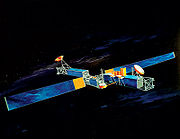- Military Strategic and Tactical Relay
-
Milstar (ursprünglich ein Akronym für englisch Military Strategic and Tactical Relay [Satellit], wird mittlerweile aber eigenständig verwandt) ist ein Satellitenkommunikationssystem der Vereinigten Staaten von Amerika. Es ermöglicht sichere, bandbreitenbeständige, weltweite Kommunikationen und dient zur Sicherung dieser in Krisen- und Kriegszeiten. Es wurde für die Anforderungen des US-Militärs entwickelt.
Eigenschaften
Milstar ist zurzeit das modernste Fernmeldesatellitensystem des US-Militärs und wird von Lockheed Martin Missiles & Systems für 800 Millionen US-Dollar pro Satellit gefertigt. Es ist ein gemeinsames Servicesystem der US-Army, US-Navy und der US-Air Force. Die funktionsfähige Milstar-Satellitenkonstellation besteht aus fünf Satelliten, die in einer geostationären Bahn um die Erde in Position gebracht wurden. Jeder Satellit wiegt circa 4,5 Tonnen und hat eine garantierte Lebensdauer von zehn Jahren.
Jeder Milstar Satellit dient als intelligente Vermittlung im Weltraum, indem er Direktverbindungen von Anschluss zu Anschluss auf der Erde herstellt. Da der Satellit wirklich das Kommunikationssignal verarbeitet und mit anderen Milstar Satelliten durch Querverbindungen kommunizieren kann, sind die Anforderungen für bodengesteuerte Schaltung erheblich verringert. Der Satellit stellt her, behält bei, rekonfiguriert und beendet erforderte Kommunikationenverbindungen die von den Benutzern gefordert werden. Milstar-Anschlüsse bieten verschlüsselte Sprach-, Daten-, Fernschreiber- oder Faksimilekommunikationen. Ein Schlüsselziel von Milstar ist, interoperable Kommunikationen unter den Benutzern der Armee, der Marine und der Luftwaffe zur Verfügung zu stellen.
Geographisch zerstreute bewegliche und örtlich feste Kontrollstationen stellen das überlebenswichtige und dauerhaft Operationskommando und die Kontrolle für das Milstar-System sicher.
Satellitenstarts
Der erste Milstar-Satellit wurde am 7. Februar 1994 an Bord einer Titan-IV-Rakete in die Umlaufbahn geschossen. Der zweite wurde am 5. November 1995 gestartet. Die vier Satelliten des zweiten Blocks haben eine deutlich erhöhte Kapazität wegen einer zusätzlichen mittleren Datenrate. Der dritte Start am 30. April 1999 brachte den Satelliten in eine unbrauchbare Bahn. Weitere erfolgreiche Starts fanden am 27. Februar 2001, 15. Januar 2002 und 8. April 2003 statt.
Satellit Datum Startort Trägerrakete Bemerkung Block 1 Milstar 1-1 (Milstar 1, USA 99) 7. Februar 1994 CCAFS Titan-4A Centaur Milstar 1-2 (Milstar 2, USA 115) 6. November 1995 CCAFS Titan-4A Centaur Block 2 Milstar 2-1 (Milstar 3, USA 143) 30. April 1999 CCAFS Titan-4B Centaur Fehlstart, zu niedriger Orbit Milstar 2-2 (Milstar 4, USA 157) 27. Februar 2001 CCAFS Titan-4B Centaur Milstar 2-3 (Milstar 5, USA 164) 15. Januar 2002 CCAFS Titan-4B Centaur Milstar 2-4 (Milstar 6, USA 169) 8. April 2003 CCAFS Titan-4B Centaur Als Nachfolgesystem wird das ursprünglich als Milstar-3 bezeichnete Advanced Extremely High Frequency-System ab 2008 ins All gebracht.
Literatur / Quellen
- USAF: Milstar Factsheet (englisch)
- globalsecurity.org: Milstar-1 (englisch)
- globalsecurity.org: Milstar-2 (englisch)
Wikimedia Foundation.


.jpg)